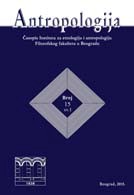АНАЛИЗА ПОЗИТИВНОГ И НЕГАТИВНОГ ОДНОСА ПРЕМА ЕКОНОМСКОМ ПОТЕНЦИЈАЛУ ГЕОГРАФСКЕ, ИСТОРИЈСКЕ И ИДЕНТИТЕТСКЕ ПОВЕЗАНОСТИ СА МОТИВОМ ВАМПИРА У СРБИЈИ
AN ANALYSIS OF POSITIVE AND NEGATIVE RELATIONS
TOWARD THE ECONOMIC POTENTIAL OF THE GEOGRAPHIC, HISTORICAL AND IDENTITY LINKS TO THE MOTIF OF THE VAMPIRE IN SERBIA
Author(s): Danilo TrbojevićSubject(s): Customs / Folklore, Cultural Anthropology / Ethnology, Culture and social structure , Sociology of Culture
Published by: Институт за етнологију и антропологију
Keywords: Dracula tourism; vampire tourism; Sava Savanović; Petar Blagojević; Arnaut Pavle; Zarožje; Kisiljevo; Medveđa; identity; economy;
Summary/Abstract: We are witnesses of the worldwide phenomenon of the exploitation of not only the character of "Count Dracula" but also the motif of vampirism in general, both in popular literature and cinema, but also in the form of museums or tourist tours. Certain parts of the world are forerunners in the context of "vampire tourism" because they are culturally and geographically linked to belief in vampires or had local vampires who became world famous throughout history. Aside from Romania which cashed in on its Dracula myth a long time ago, Serbia has great potential to realize an especially attractive offer of vampire tourism. Namely, there is an almost thousand-year old tradition of belief in vampires in Serbia, and the western literary and later cinematic vampire (including Stoker’s Dracula) came into being thanks to cases of vampirism noted in Serbia in the 18th century. This paper deals with the ways in which different interest groups approach the idea of commercializing both nationally popular and internationally famous vampires in Serbia. The aim of this paper is to give an analysis of the positive and negative attitudes toward the use of the motif of the "local vampire" which the residents and representatives of three villages and one town displayed in the media. The analysis of these initiatives encompasses the dispute between Valjevo and Zarožje over the use of "Sava Savanović" as their own, and the attitudes of the villages of Kisiljevo and Medveđa which have attempted to erase "local vampires" from the collective memory and identity of the villages. In both cases – the positive and the negative attitudes towards the identity connection with "local vampires", I have attempted to determine the influence of the socio-economic context and migrations on the attitudes and initiatives supported by these locales.
Journal: Antropologija
- Issue Year: 15/2015
- Issue No: 1
- Page Range: 93-128
- Page Count: 36
- Language: Serbian

